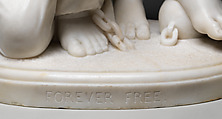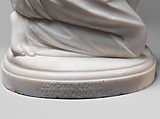Returned to lender The Met accepts temporary loans of art both for short-term exhibitions and for long-term display in its galleries.
Forever Free
Edmonia Lewis American
Not on view
Lewis, a sculptor of African American and Ojibwe heritage, completed Forever Free in Rome in 1867, two years after emancipation in the United States and a year before Carpeaux finished Why Born Enslaved! Whereas Carpeaux represents the theme of abolition by sculpting a bound woman, Lewis sculpts two free figures. Unlike virtually all other such images of the period, the Black man stands rather than sits or kneels. With a broken shackle in hand, he raises aloft his fist in a gesture of strength and self-determination. He rests his other hand protectively on the shoulder of his female companion who kneels and clasps her hands in gratitude. The differing postures of Lewis’s figures anticipates the divergent experiences of emancipated men and women. Yet the inscription on the base, neither pleading nor beseeching, proclaims: "Forever Free."
Due to rights restrictions, this image cannot be enlarged, viewed at full screen, or downloaded.
This artwork is meant to be viewed from right to left. Scroll left to view more.







